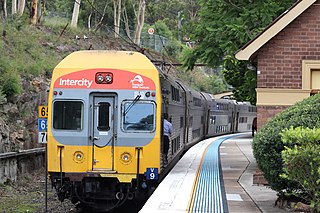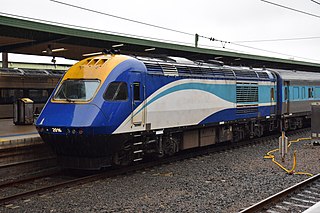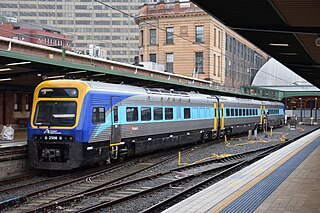
CityRail was a passenger railway brand operated by the State Rail Authority from 1989 to 2003 and by RailCorp from 2003 to 2013 with services in and around Sydney, Newcastle and Wollongong, the three largest cities in New South Wales, Australia. It was established in January 1989 and abolished in June 2013 when it was superseded by Sydney Trains and NSW TrainLink.

CountryLink was a passenger rail and road service brand that operated in regional areas New South Wales, Canberra, Brisbane and Melbourne. Originally created as a business unit of the State Rail Authority of New South Wales, it later became a subsidiary of RailCorp, a Government of New South Wales entity. CountryLink operated rail services using XPT and Xplorer rolling stock, with connecting coach services operated under contract by private operators.

The South Coast Line is an intercity rail service operated by NSW TrainLink that services the Illawarra region of New South Wales, Australia. The service runs from Central, and runs the entire length of the eponymous South Coast railway line to Bomaderry. The service also runs along the Eastern Suburbs railway line at peak hours and the Port Kembla railway line to Port Kembla. It is operated with NSW TrainLink H sets and Sydney Trains T sets, with Endeavour railcars operating the service on the non-electrified line between Kiama and Bomaderry.

The Australind is a rural passenger train service in Western Australia operated by Transwa on the South Western Railway between Perth and Bunbury.

The Southern Highlands Line is an Intercity rail service operated by NSW TrainLink that services the Macarthur, Southern Highlands and Southern Tablelands regions of New South Wales. First operating in 1869, the service runs from Campbelltown across the Main Southern railway line through to Goulburn, with peak hour services extending the route to Central. The railway service operates alongside a bus route from Picton to Bowral, operating on the route of the Picton – Mittagong loop railway line, and a regional coach service from Bundanoon to Wollongong on the South Coast Line, operating on the corridor of the Unanderra–Moss Vale railway line.

The Blue Mountains Line (BMT) is an inter urban commuter rail service operated by NSW TrainLink serving the Blue Mountains region of New South Wales, Australia. The line travels west from Sydney to the major town of Katoomba and on to Mount Victoria, Lithgow and Bathurst. Mount Victoria is the terminus for most electric services, but some services terminate at Lithgow instead. Two express services per day in each direction, known as the Bathurst Bullet, extend to the regional city of Bathurst, which is supplemented by road coaches connecting Bathurst to Lithgow. Due to electrification limits at Lithgow, the Bathurst Bullet is run using the Endeavour railcars, which operate on diesel. The Blue Mountains Line operates over a mostly duplicated section of the Main Western line. As such, the tracks are also traversed by the Central West XPT, Outback Xplorer and Indian Pacific passenger services and by freight trains.

The 620/720 class railcars were a class of diesel multiple unit built by the New South Wales Government Railways and operated from 1961 until 2007.

The Hunter Railcars are a class of diesel multiple unit operated by NSW TrainLink on the Hunter Line in New South Wales, Australia. Built by UGL Rail between November 2006 and September 2007, they initially operated for CityRail.
The railways of New South Wales, Australia, use a large variety of passenger and freight rolling stock. The first railway in Sydney was opened in 1855 between Sydney and Granville, now a suburb of Sydney but then a major agricultural centre. The railway formed the basis of the New South Wales Government Railways. Passenger and freight services were operated from the beginning. By 1880, there was a half hourly service to Homebush.

The New South Wales XPT is a class of diesel-powered passenger trains built by Comeng and ABB Transportation. Based on the British Rail designed InterCity 125, each XPT set is made up of two XP Power Cars in a push-pull formation coupled to between four and seven carriages. The first sets entered service under the State Rail Authority in 1982 and now operate under NSW TrainLink, running on long-distance regional and interstate North Coast, Main Western and Main Southern lines throughout New South Wales and interstate into Victoria and Queensland.

The Xplorer Railcar is a class of diesel multiple unit trains built by ABB Transportation. Initially entering service in October 1993, the Xplorers are mechanically identical to the Endeavour Railcars, though feature a higher level of passenger amenity. All 23 carriages were built in Dandenong, Victoria. The Xplorers currently operate under NSW TrainLink, running on the regional Main North, Main Western and Main Southern lines throughout New South Wales.

The Silver City Comet was a train service that operated from September 1937 until November 1989 between Parkes and Broken Hill in western New South Wales. It was the first air-conditioned train in Australia.

The 900/800 class railcars were diesel multiple units built by the New South Wales Government Railways between November 1951 and November 1960.

The 600/700 class railcars were a class of diesel multiple unit built by the New South Wales Government Railways. They were built to operate on branch lines from 1949 with low traffic volumes later being transferred to Newcastle and Wollongong to operate suburban services until withdrawn in 1994. However, one 600 class railcar was converted to solar operation for use on the Byron Bay Train service. The upgraded train entered service on 16 December 2017 and is believed to be the world's first solar-powered train.

The South Coast Daylight Express was a limited stops passenger train operated by the New South Wales Government Railways and its successors between Sydney and Bomaderry from 1933 until January 1991.
The 1100 class railcar or Budd railcar were a type of diesel railcar built by Commonwealth Engineering for the Department of Railways New South Wales in 1961. They primarily operated on the South Coast Daylight Express until withdrawn in 1993.

The 1200 class railcar or Tulloch railcar were a type of diesel railcar built by Tulloch Limited for the New South Wales railways department between June 1970 and May 1972. They were built to operate the Riverina Express before being transferred to the South Coast Daylight Express.

NSW TrainLink is a train and coach operator in Australia, providing services throughout New South Wales and the Australian Capital Territory, along with limited interstate services into Victoria, Queensland and South Australia. Its primary intercity and regional services are spread throughout five major rail lines, operating out of Sydney's Central railway station.
The NSW TrainLink fleet of trains serves the areas outside Sydney, Australia, mainly interurban and interstate lines. The NSW TrainLink fleet consists of both diesel and electric traction, with the oldest of the fleet being the V sets and the youngest being the H sets.

The Bathurst Bullet is an express passenger train on the Blue Mountains Line operated by NSW TrainLink between Sydney and Bathurst. The service operates from Bathurst towards Sydney in the morning, and returns in the afternoon.





















